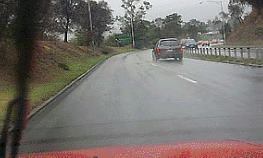A. Pull over and wait till it stops raining.
 You are driving in busy traffic in an 80 km/h zone. It begins to rain lightly. What should you do?
You are driving in busy traffic in an 80 km/h zone. It begins to rain lightly. What should you do?
A. Pull over and wait till it stops raining.
B. Slow down to a speed that suits the conditions better.
C. Keep going at the same speed because that's how fast the signs tell you to drive.
The type of rain and what the weather was like before the rain will influence the slipperiness of the road.
If there was a prolonged period of sunny weather before the rain then the surface can become very slick, especially with only light rain where there's not enough water to help wash the surface oil and dirt away quickly.
With heavy rain there will be spray from other vehicles and this can reduce visibility quite a lot. Rain might also mean it becomes overcast, but if it's raining and still sunny then glare can be a problem off the wet bitumen.
Torrential downpours can result in large amounts of standing water or flash floods. If the rain is too fast for your wipers to keep up, pull over and wait until it stops. This type of heavy rain can dislodge foliage from trees, and wash items into the roadway.
If the rain causes deep puddles and standing water there is the risk of hydroplaning or aquaplaning where the tyre rides up on top of the water.
Put your dipped headlights on if visibility falls below 100m.
Pedestrians are more likely to take risks running across the road to escape the rain. If they have umbrellas an umbrella makes it more difficult for them to see.
Be careful that you don't splash a pedestrian by driving quickly through deep water.
Take care if you have to cross a ford or causeway (where a stream crosses the road) because water levels can rise rapidly and the force pushing against the side of your vehicle could sweep it away.
Remember that it's not a good idea to use your cruise control when it's very slippery unless your vehicle has traction control (and preferably some form of electronic stability control such as ESC, ESP [electronic stability program] or VDC [vehicle dynamics control]).